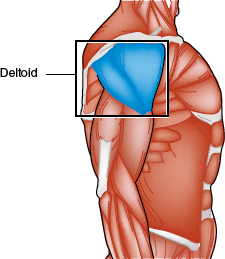
Overhead pressing exercises using free weights, a pulley or pivot machine, or a cam machine are excellent for developing the front, middle, and posterior sections of the shoulder (anterior, middle, and posterior heads of the deltoid). They also develop the back of the upper arm (triceps). These exercises contribute to a stable shoulder joint and help balance the strength of the chest, neck, and upper back muscles.

The free-weight standing press, sometimes called the military press, is generally considered to be the best shoulder exercise, although the free-weight *upright row is a good alternative because it does not involve (and therefore fatigue) the triceps.
If you have access to free weights, you are encouraged to select the standing press or the *upright row to develop your shoulders. If you have access to either a cam or a multi- or single-unit machine, choose either the shoulder press exercise or seated press exercise to develop your shoulders. These two exercises involve nearly the same movements but are performed with different types of machines.
To prepare for this exercise, place the bar on a squat rack or set of supports at shoulder height. If racks or supports are not available, you must lift the bar from the floor using the techniques presented in step 2.
Grasp the bar in an overhand grip, with your hands equidistant from the center of the bar and slightly more than shoulder-width apart. With your elbows under the bar, your wrists should be in a slightly extended position. The bar should be resting on your shoulders, clavicles (collarbones), and hands (figure 6.1a).

MISSTEP
Your grip is too wide or uneven.
CORRECTION
Evenly space your hands shoulder-width apart, using the markings on the bar for reference.
Push the bar upward in a straight line above your shoulders at a slow to moderate speed until your elbows are fully extended (figure 6.1b). You will need to move your head slightly backward as the bar reaches chin level during the upward and downward movements. Otherwise, keep your head in a neutral position throughout this exercise. Avoid leaning back or hyperextending the spine, especially during the upward movement phase.

MISSTEP
You start the bar upward with a knee kick (flexion, then a quick extension).
CORRECTION
Start with your knees in a fully extended position and keep them that way throughout the upward and downward movements of the bar.
Pause momentarily at the top; then lower the bar slowly to the starting position (figure 6.1a). Do not bounce the bar on your upper chest or front shoulders. Inhale as you lower the bar and exhale as it passes through the sticking point during ascent. After the last repetition, rack the bar (not shown in figure 6.1). If you must lower the bar to the floor after completing the exercise, use the shoulder-to-floor lowering techniques presented in step 2.
CAUTION: Be careful not to hold your breath through the sticking point; doing so could cause you to pass out. Exhale as the bar moves through the sticking point.
As the spotter, stand directly behind your partner as close as you can without causing contact (figure 6.1a). With outstretched arms and your open hands under (but not touching) the bar, follow it as it moves up and down (figure 6.1b). Once your partner has given the “OK” signal after the last repetition, grasp the bar and help return it to the rack supports before releasing it (if a rack is available).

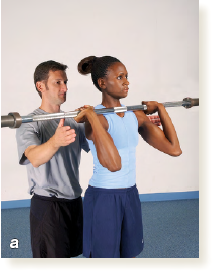
Preparation
Spotter
1. Stand directly behind partner as close as possible without touching
2. Watch the bar
3. Keep feet shoulder-width apart
Lifter
1. Use an overhand grip, hands evenly spaced, shoulder width or slightly wider
2. Hold head upright, facing forward
3. Position elbows under bar, wrists extended
4. Hold bar in hands, resting it on shoulders and clavicles
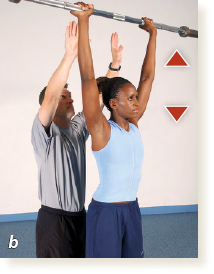
Movement
Spotter
1. Keep hands close to bar, tracking movement
2. Assist only when necessary
3. Caution partner not to lean back or hold breath
Lifter
1. Push bar straight up
2. Keep torso erect
3. Exhale through sticking point
4. Pause at top of movement
5. Return to starting position while inhaling
6. Continue upward and downward movements until set is complete
7. Signal “OK” on last repetition
MISSTEP
Your eyes are closed during the exercise.
CORRECTION
Focus on an object straight ahead, especially when you reach the sticking point.

MISSTEP
Your arms extend unevenly.
CORRECTION
Keep both arms moving upward in unison by visually focusing and concentrating on the arm that lags behind.
Of the errors commonly seen in the standing press, leaning back too far is the most common. This typically occurs at the bar’s sticking point. It should be avoided because it places extra stress on the low back. Think: Torso, head, and bar form a straight line.
Position yourself on the seat of the cam machine with your back against the pad, your shoulders aligned under the handles, and your feet flat on the floor. Grasp the handles with a closed grip (figure 6.2a).
From this position, push the handles up to full elbow extension in a slow, controlled manner (figure 6.2b). Exhale when passing through the sticking point. Pause at full extension; then return to the starting position while inhaling (figure 6.2a).

MISSTEP
Your low back is not against the back pad.
CORRECTION
Slide back on the seat until your low back is pressed against the back pad.

MISSTEP
You hold your breath during the sticking point.
CORRECTION
Begin to exhale as soon as the bar nears the extended-elbow position.
The most common error made during the shoulder press is arching the low back when the sticking point is reached. The back should be kept flat against the pad because the arched position places too much stress on the low back. Concentrate on keeping your buttocks stationary and your low back pressed against the back pad.

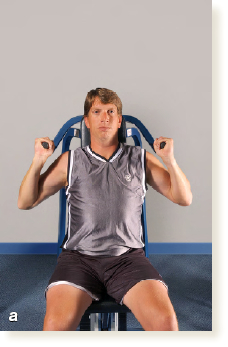
Preparation
1. Get into a seated position against back pad
2. Grasp the handles with a closed grip
3. Place feet flat on floor
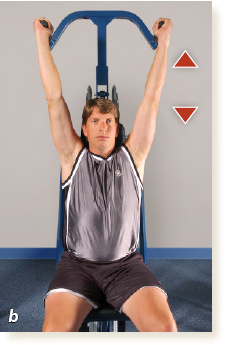
Movement
1. Push up to full elbow extension
2. Keep elbows directly under wrists and torso erect
3. Exhale through sticking point of upward movement
4. Pause
5. Return to starting position while inhaling
6. Continue upward and downward movements until set is complete
Sit erect on the stool of the multi- or single-unit weight machine so that the front of your shoulders is directly below the handles (figure 6.3a) with your feet flat on the floor. Grasp the handles with a closed grip slightly wider than shoulder-width apart.
Push the handles up until your elbows are fully extended (figure 6.3b). Keep your shoulders directly under the handles throughout the exercise. Keep your low back flat by pressing it into the back pad. Exhale as your elbows near the fully extended (sticking point) position. Pause when your elbows are fully extended; then slowly return to the starting position (figure 6.3a).

Figure 6.3 SEATED PRESS (MULTI- OR SINGLE-UNIT MACHINE)
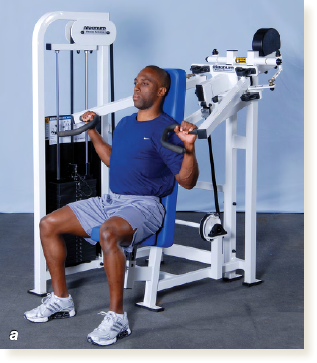
Preparation
1. Sit erect on stool or seat so that front of shoulders is directly below handles
2. Grip handles with closed grip at approximately shoulder width
3. Place feet flat on floor
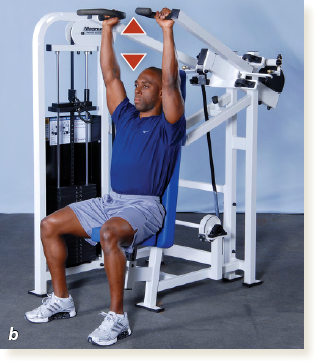
Movement
1. Push up to full elbow extension
2. Keep torso erect
3. Exhale during upward movement
4. Pause
5. Return to starting position while inhaling
6. Continue upward and downward movements until set is complete

MISSTEP
You hold your breath.
CORRECTION
Begin to exhale when the handles reach the sticking point.
The most common errors made during the seated press are hyperextending (excessively arching) the low back and failing to lower the handles to shoulder level. Keep the back flat by sitting erect on the seat by contracting your abdominal and low back muscles. Think: Head, torso, and buttocks form a straight line.
Failing to lower the handles to the starting position reduces the range through which the shoulder muscles are exercised, thus minimizing their development. Try to lower the handles so the weight plates lightly touch the rest of the weight stack. To keep the weight plates from banging against each other, control the handles’ downward momentum and pause at shoulder level before pushing upward for the next repetition.
 UPRIGHT ROW
UPRIGHT ROWIf you are an experienced lifter who wants to add a second shoulder exercise to your program, consider adding the *upright row. In addition, if you find that the first plate on the machine for the seated or shoulder press is too heavy, you can substitute the *upright row using an empty bar.
The *upright row also develops the deltoids, but it differs from other shoulder exercises because it uses a pulling motion and does not involve the triceps muscle. This exercise can be performed using a barbell, dumbbells, or the low-pulley station on a machine. Figure 6.4 shows a lifter using a barbell.
Grasp the barbell in an overhand grip, 6 to 8 inches (15-20 cm) apart (figure 6.4a). Stand with your torso erect, arms straight, and feet shoulder-width apart. Rest the bar on your thighs. (See step 2, page 18, for more information on lifting the bar from the floor to the thighs.)
Pull the bar up along your abdomen and chest (figure 6.4b). Keep your elbows higher than your wrists and point them out to the sides. Pull the bar up until your elbows are at shoulder height and exhale as the bar nears your shoulders. Pause briefly at the top of the movement.
Inhale as you lower the bar to the starting position (figure 6.4a) in a smooth motion. Pause at the bottom of the movement before beginning the next repetition.

MISSTEP
You allow your elbows to drop below your wrists.
CORRECTION
Keep your elbows high and pointed up as you raise the bar.

MISSTEP
You allow the bar to drop too quickly back to the starting position.
CORRECTION
Pause at the top position; then slowly return the bar to the starting position.

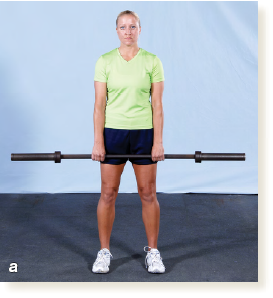
Preparation
1. Use an overhand grip
2. Place hands 6 to 8 inches (15-20 cm) apart
3. Hold torso erect
4. Place feet shoulder-width apart
5. Fully extend elbows
6. Rest bar on thighs

Movement
1. Pull bar upward along abdomen and chest
2. Point elbows out and higher than wrists
3. Pull until elbows reach shoulder height
4. Exhale as bar nears shoulders
5. Pause briefly at top position
6. Return to starting position while inhaling
7. Continue upward and downward movements until set is complete
Shoulder Drill 1. Choose One Exercise
After reading about the characteristics and techniques of the exercises and the type of equipment required for each, you are ready to put this information to use. Consider the availability of equipment and access to spotters in your situation; then select one of the following exercises to use in your program:
Standing press (free weight)
Shoulder press (cam machine)
Seated press (multi- or single-unit .machine)
Write in “Shoulders” in the “Muscle group” column on the workout chart and fill in the name of the exercise you selected in the “Exercise” column (see figure 11.1 on page 146). If you intend to include the free-weight *upright row, record it on the workout chart immediately after the previously selected shoulder exercise.
Success Check
Consider availability of equipment.
Consider need for a spotter and the availability of a qualified professional.
Consider time available.
Choose a shoulder exercise and write it on the workout chart.
Shoulder Drill 2.
Warm-Up and Trial Loads for Basic Exercises
The next practice procedure answers the question “How much weight or load should I use?” Using the coefficient associated with the shoulder exercise you selected and the formula shown in figure 6.5, determine the trial load. (See step 3, pages 33-34, for more information on using this formula.) Round your results down to the nearest 5-pound (2.3 kg) increment or to the closest weight-stack plate. Be sure to use the coefficient assigned to the exercise you selected. Use half of the amount determined for the trial load for your warm-up load in the exercise. These loads will be used in drills 4 and 5.
Success Check
Determine your trial load by multiplying your body weight by the correct coefficient.
Determine your warm-up load by dividing the trial load by two.
Round down your trial and warm-up loads to the nearest 5-pound (2.3 kg) increment or to the closest weight-stack plate.
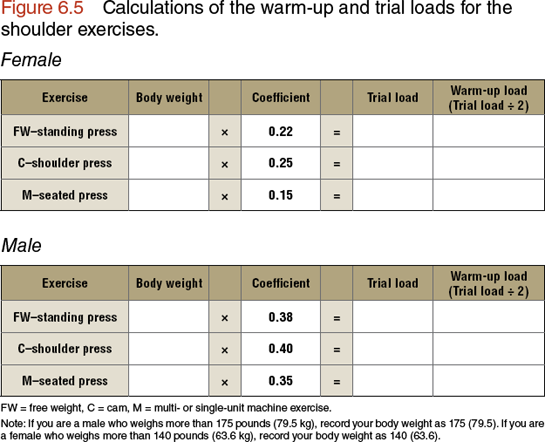
Shoulder Drill 3.
Determine Trial Load for *Upright Row
If you are an experienced lifter who decided to add the *upright row, follow the directions to determine your trial load. (See step 3, pages 34-35 for more information.)
Based on your previous experience and knowledge of the weight that you can lift, select a weight that will allow you to perform 12 to 15 repetitions. Calculate the warm-up load by multiplying the trial load by 0.6 and round down to the nearest 5-pound (2.3 kg) increment or to the closest weight-stack plate (figure 6.6). These loads will be used in drill 4.
Success Check
Select a weight that will allow 12 to 15 repetitions.
Determine the warm-up load by multiplying the trial load by 0.6.
Round down the warm-up load to the nearest 5-pound (2.3 kg) increment or to the closest weight-stack plate.

Shoulder Drill 4.
Practice Proper Technique
In this procedure, you are to perform 15 repetitions with the warm-up load determined in drill 2 (standing press, shoulder press, or seated press) or drill 3 (*upright row). If you are an experienced lifter who decided to add the *upright row, practice it last.
Review the photos and instructions for the exercise, focusing on proper grip and body positioning. Visualize the movement pattern through the full range of motion. Perform the movement with a slow, controlled velocity, remembering to exhale through the sticking point. Ask a qualified professional to observe and assess your technique.
If you selected the free-weight standing press, you need a spotter. You also need to practice the skills of spotting this exercise. Identify a spotter with whom you will take turns completing the drill.
Instead of performing 15 repetitions in a continuous manner, rack the bar after each repetition for practice. Alternate responsibilities so that you and your partner both have a chance to develop the proper techniques for performing and spotting this exercise. Ask a qualified professional to observe and assess your performance in the basic techniques.
Success Check
For the standing press, all rackings are performed correctly.
For all exercises, movement pattern, velocity, and breathing are correct.
Shoulder Drill 5.
Determine Training Load
This practice procedure will help you determine an appropriate training load designed to produce 12 to 15 repetitions. For basic exercises, perform as many repetitions as possible with the calculated trial load from drill 2. Make sure that you perform the repetitions correctly.
If you performed 12 to 15 repetitions with the trial load, then your trial load is your training load. Record this number as your training load for this exercise on the workout chart (see page 146). If you did not perform 12 to 15 repetitions, go to drill 6 to make adjustments to the load.
Success Check
Check that you are using the correct load.
Maintain proper and safe technique during each repetition.
Shoulder Drill 6.
Make Needed Load Adjustments
If you performed fewer than 12 repetitions with your trial load, it is too heavy, and you need to lighten it. On the other hand, if you performed more than 15 repetitions, the trial load is too light, and you need to increase it. Use figure 6.7 to determine the adjustment you need to make and the formula for making load adjustments.
Success Check
Check correct use of load adjustment chart (figure 6.7).
Record your training load on the workout chart (see page 146).
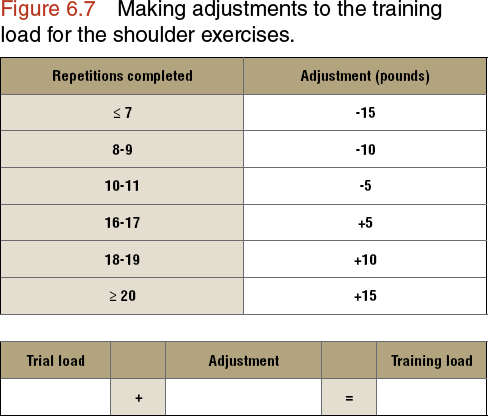
This step involved selecting one shoulder exercise for which you have the needed equipment and perhaps one more if you have already been training. Using a proper grip, the correct body position, movement, and breathing patterns, and accurate warm-up and training loads will maximize your success.
After you have determined your training load and recorded it on your workout chart, you are ready to move on to step 7. In this step you will select exercises that are designed for developing the arms, including four for the front of the arm and four for the back of the arm.
Before Taking the Next Step
Honestly answer each of the following questions. If you answer yes to all of the questions relevant to your level and exercise selection, you are ready to move on to step 7.
1. Have you selected a basic shoulder exercise? If you are an experienced lifter, do you want to add the *upright row?
2. Have you recorded your exercise selection (or selections) on the workout chart?
3. Have you determined a warm-up and training load for the exercise(s) you selected?
4. Have you recorded the training load(s) on the workout chart?
5. Have you learned the proper technique for performing the exercise(s) you selected?
6. If the exercise(s) you selected require a spotter, have you identified a qualified professional? Have you learned the proper spotting techniques?